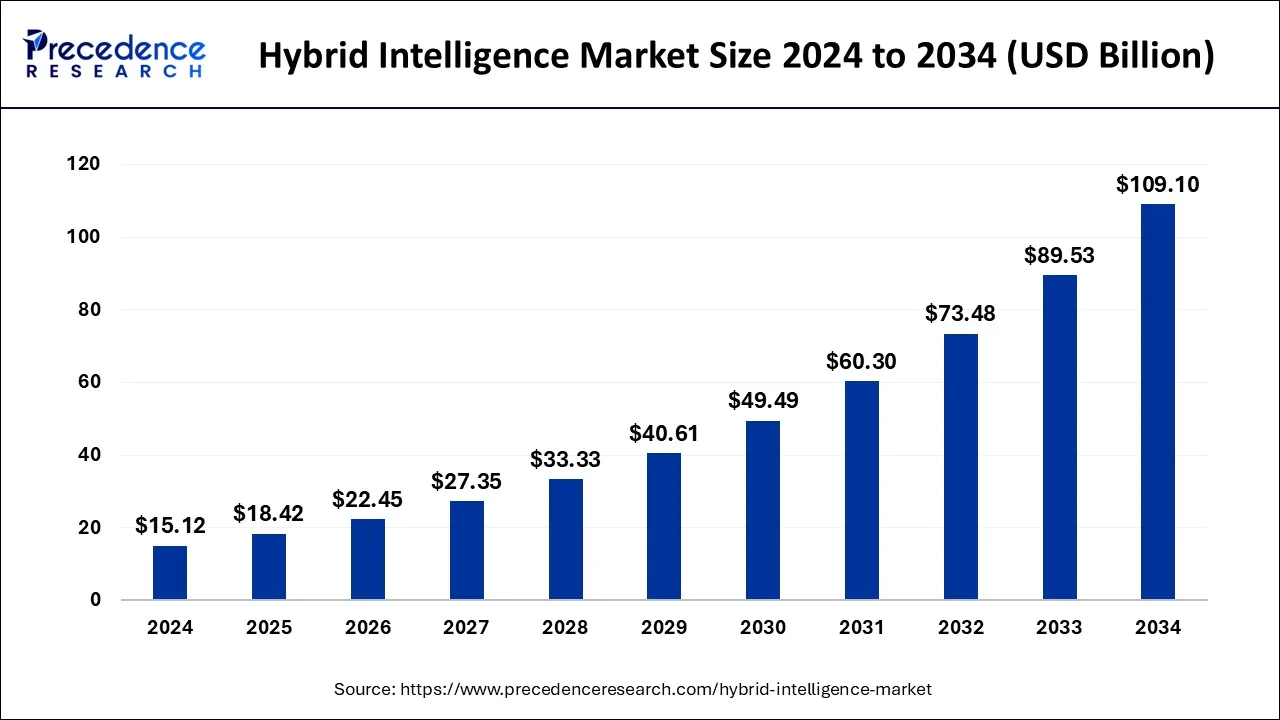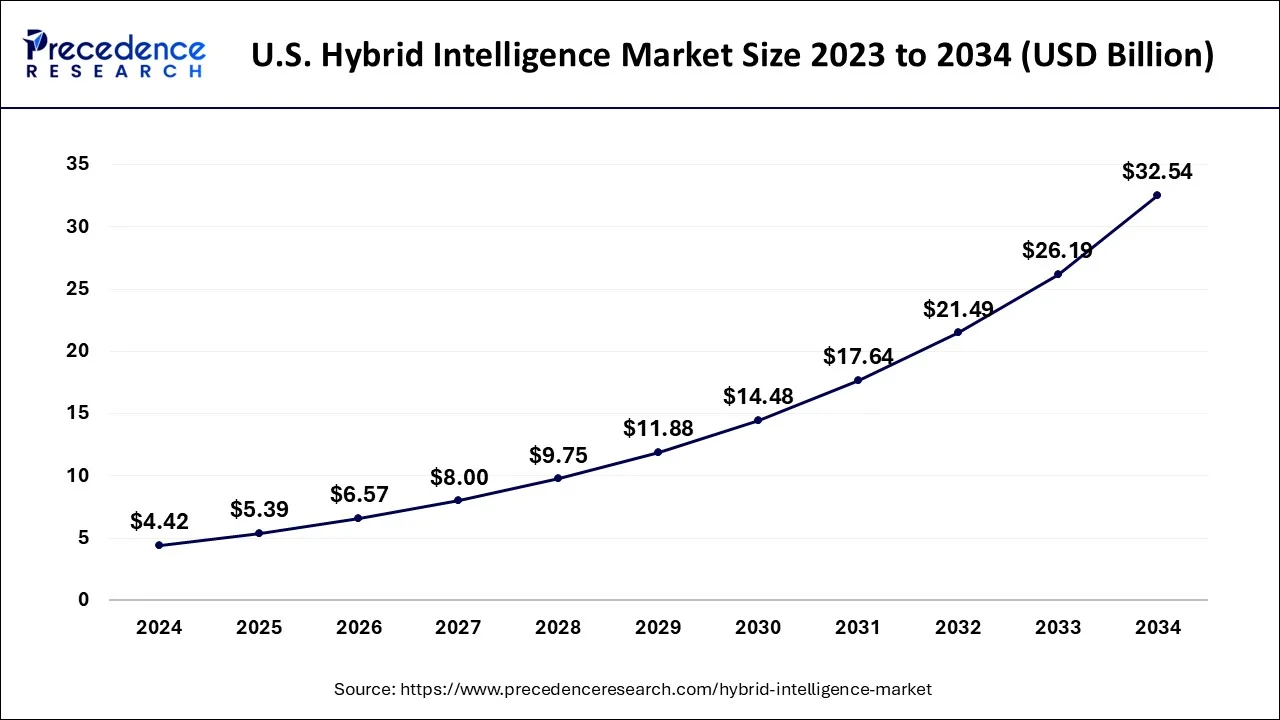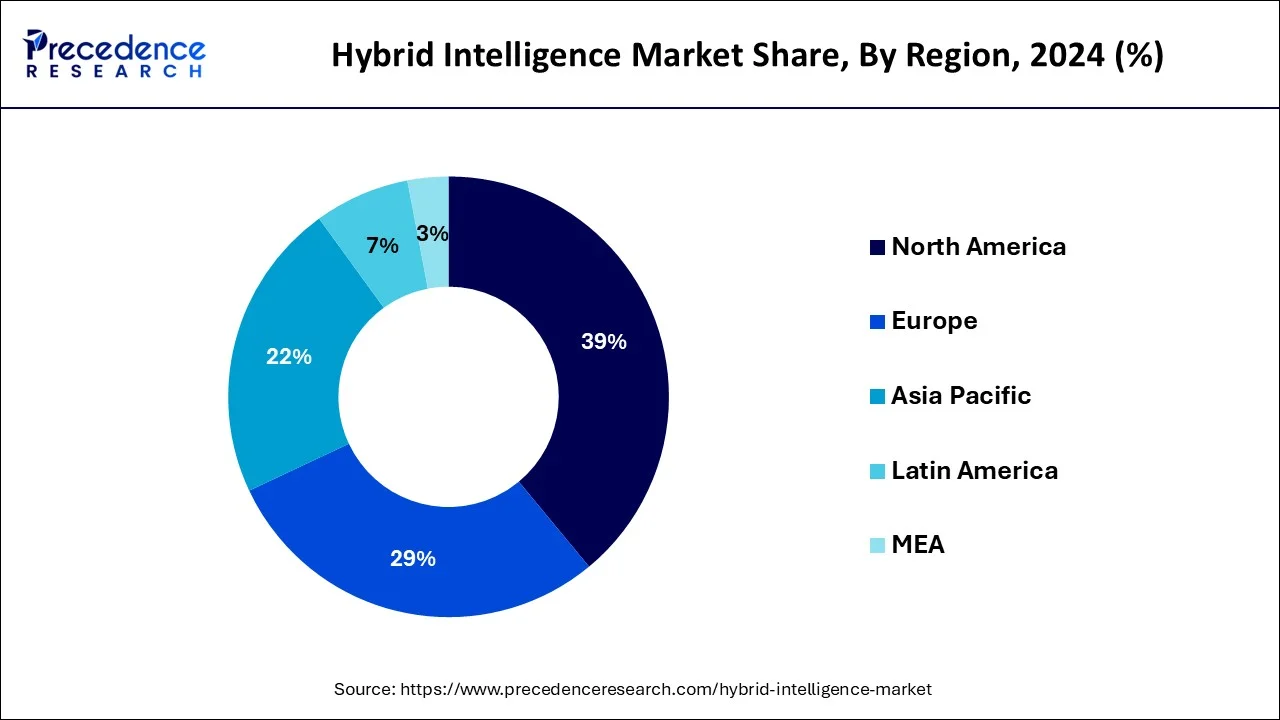List of Contents
Hybrid Intelligence Market Size and Forecast 2025 to 2034
The global hybrid intelligence market size was estimated at USD 15.12 billion in 2024 and is anticipted to reach around USD 109.10 billion by 2034, expanding at a CAGR of 21.85% between 2025 and 2034. The market growth is attributed to the increasing adoption of AI technologies across industries, driving efficiency, automation, and data-driven decision-making.

Hybrid Intelligence Market Key Takeaways
- North America dominated the global hybrid intelligence market with the largest market share of 39% in 2024.
- By region, the Asia Pacific is projected to host the fastest-growing market in the coming years.
- By component, the solutions segment accounted for the biggest market share in 2024.
- By component, the professional and managed segment is expected to grow at the fastest rate in the market during the forecast period of 2025 to 2034.
- By vertical, the banking segment contributed the highest market share in 2024.
- By organization type, the large segment accounted for a considerable share of the market in 2024.
- By vertical, in 2023, the banking sector segment led the global market.
- By vertical, the consumer goods segment is projected to expand rapidly in the market in the coming years.
Impact of Artificial Intelligence on the Hybrid Intelligence Market
Machine learning and natural language processing enhance the business operation decision-making process through the infusion of human experience and AI performances. It also improves management since the functions are combined to allow efficiency and better use of resources while improving the ability to predict. The advancement of AI in pivotal areas, such as healthcare, financial, and customer service industries has laid the foundation for more innovative, flexible, and molding systems. Furthermore, AI is expected to help enhance the interaction between human workers and smart machines providing opportunities to increase the levels of innovation and detect new opportunities for business.
Hybrid Intelligence Market Size and Growth 2025 to 2034
The global hybrid intelligence market size accounted for USD 4.42 billion in 2024 and is expected to be worth around USD 32.54 billion by 2034, growing at a CAGR of 22.09% between 2025 and 2034.

North America led the hybrid intelligence market, capturing the largest market share in 2024, due to the recent improvements of hybrid intelligence and its usage in many sectors including finance, healthcare, and retail. The United States is the domicile to most developers and startups in hybrid intelligence technology the region experiences significant development. Moreover, the rising need for the incorporation of this technology into processes to enhance productivity, customer relations, and decision-making in sectors of health and financial services is expected to boost the market in the coming years.

Asia Pacific is expected to grow at the fastest rate in the hybrid intelligence market during the forecast period, owing to the digitization and increased rollout of technology in the core countries including China, Japan, and India. The increasing rate of the implementation of smart hybrid intelligence in different sectors, such as manufacturing, retail trade, healthcare, and finance is expected to fuel the revenue growth in the region. Newer concepts such as, smart cities, and automation in manufacturing are expected to be new growth drivers apart from the increased interest being shown in hybrid intelligence research and development.
Market Overview
The formation of actionable data which is derived from a content provided by software on the basis of intelligence helps to enhance the view for the marketers regarding strategy making and tactics in the market. The language used by the content writer is assessed by having a complete view, which helps them to take appropriate decisions regarding the context of the write-up. Generally, helps the market to understand the strategies better and to form a suitable basis for the decisions taken by them in order to achieve the appropriate results expected by them during the forecast period. The increasing requirement of improving the strategy which is used for making the content will help to profile the goals said by the business by reaching a huge audience and thus help to produce tremendous revenue during the forecast period.
In order to increase the returns by the formation of relevant content strategy helps to enhance the business by reaching masses all over the globe. This strategy will prove to be a significant change in the format the market works and will help it to grow by making use of hybrid technology and content thus created. This process of conversion of data into hybrid intelligence format helps the business to have a clear picture regarding their choices and decisions which ultimately reflects in their portfolio during the forecast period. The marketing industry is also making greater use of content formation created for expanding the business goals during the forecast period. The demand for creation of a data which attracts the audience propels the need for hybrid intelligence and market content in order to capture a larger population for business. The barriers which are found in the market in terms of content and information hampers the growing phase of the market.
The availability of relevant information also becomes a challenge for the market as it directly makes an impact on the direction the market will show its growth into. The importance of relating relevant information to the right consumer becomes a challenge which hampers the growth of the market by providing unnecessary data to the masses which do not return the required response expected from the audience. Thus, the content created comes under doubt and its value is hampered during the future prospects. The absence of the right audience for a specific type of data created is very harmful for the growth of the market.
The huge amount of information available regarding various industries creates confusion regarding its authenticity and hence hampers the quality of work exhibited during the creation of content for marketing purposes. The lack of resources to process such massive information that is available in the market reduces the productivity regarding the market intelligence content supplied for the consumers which further hampers the growth of the market during the forecast period. The goals of the market greatly depend on the data that is supplied to the consumers in order to attract the attention of the relevant opportunities that helps to multiply the customer base of the business creating a strong foot hold for the market.
The quality of content is constantly affected by the shortage of quality resources which have the ability to customize and create hybrid intelligence market information. These multiple factors foreseen by the market experts tend to hamper the growing phase of the market during the forecast period by hindering the revenue returns of the companies. Lack of considerable time regarding the processing of this huge information into relevant market intelligence data hampers the growth of the market to a great extent.
Hybrid Intelligence Market Growth Factors
- Advancements in machine learning algorithms are expected to improve the capabilities of hybrid intelligence systems, driving market growth.
- Increasing data volumes across industries are likely to create a higher demand for AI-driven data analysis and decision-making tools.
- Rising investments in AI research and development from both public and private sectors are projected to accelerate hybrid intelligence adoption.
- Growing reliance on cloud computing is expected to enhance the scalability and accessibility of hybrid intelligence solutions.
- Improved human-AI collaboration tools are anticipated to foster better integration of AI technologies into everyday business operations.
- Government regulations promoting AI adoption are likely to support hybrid intelligence development in key sectors like healthcare and finance.
- The shift towards Industry 4.0 is projected to drive the demand for intelligent automation solutions, further boosting the hybrid intelligence market.
Market Scope
| Report Coverage | Details |
| Market Size by 2034 | USD 109.10 Billion |
| Market Size in 2024 | USD 15.12 Billion |
| Market Size in 2025 | USD 18.42 Billion |
| Market Growth Rate from 2025 to 2034 | CAGR of 21.85% |
| Largest Market | North America |
| Base Year | 2024 |
| Forecast Period | 2025 to 2034 |
| Segments Covered | Component, Organization, Vertical, and Regions |
| Regions Covered | North America, Europe, Asia-Pacific, Latin America, and Middle East & Africa |
Market Dynamics
Driver
Rising Demand for Automation
Rising demand for automation across various industries is expected to drive significant growth in the hybrid intelligence market. According to the 2023 report published by the United States Census Bureau, approximately 30% of all workers face potential exposure to advanced technologies utilized for automation purposes, with manufacturing workers being significantly more exposed compared to workers in other industries. Businesses are looking for a way to make their processes faster, with less interference from human factors, which has shown that there is a growing demand for the application of AI solutions in managing an organization. Some of the sectors that have a large and growing interest in the automation of repetitive work, process optimization, and enhanced decision-making are the manufacturing, healthcare, and retail sectors. This change is expected to improve efficiency and operating adaptability for organizations, making them devote their time to core business plans as rest of the work is being handled by hybrid solutions. Thus, there are expectations for businesses to incorporate hybrid intelligence solutions further stimulating the market demand.
Restraint
High Implementation Costs
High implementation costs are expected to hamper the growth of the hybrid intelligence Market. SMEs face the problem of procurement of advanced AI technologies as hybrid intelligence systems installed in business environments and require significant investments. Acquisition costs, installation costs, and finally the cost of skilled labor all add to the cost. While large organizations have adequate capital to accommodate these costs, small companies possibly experience difficulties in implementing these systems. This difference results in a slower diffusion of hybrid intelligence solutions and consequently inhibits market growth in terms of advanced solutions in the coming years.
Opportunity
Increasing Focus on Cybersecurity
Increasing focus on cybersecurity presents a valuable opportunity for the hybrid intelligence market. The increasing sophistication of threats, organizations need to implement hybrid intelligence systems for the enhancement of their security frameworks. There is a tremendous amount of security data that be analyzed for threats in real-time, while on the other hand, an experienced human being decides what the right action should be. Hybrid intelligence systems give the potential for system surveillance, threat dynamics, and risk management all the time.
Furthermore, the dangers of data breaches and cyber-attacks continue to increase, it is expected that many firms across numerous industries spend a lot of their funds on the deployment of AI-driven cybersecurity platforms, which in turn will enhance the demand for such solutions. According to the 2024 report by Astra Security, a cybersecurity company, statistics reveal that an alarming 2,200 cyberattacks occur daily, averaging one cyberattack every 39 seconds. Furthermore, the growing trend of the cyber threat and suggests the higher use of an hybrid intelligence approach to cybersecurity for more effective protection of infrastructure and important information further fuels the market.
Vertical Insights
Banking segment dominated the hybrid intelligence market. Large banks are especially expected to increase the use of hybrid systems that deploy AI for processes and functions such as operations, risk management, fraud detection, and customer services. Human beings and hybrid intelligence bring a level of efficiency in solving problems without the hassles of involving human personnel in all the decision-making tasks and service deliveries in banks. The Federal Reserve of the United States reported in 2023 that AI application in banking has escalated by 35% within the subsequent years, especially in issues such as fraud detection and predictive analysis. Furthermore, the threats and requirements for cybersecurity and regulation further fuel the demand for hybrid intelligence security solutions in the coming years.
Consumer goods sub-segment is projected to grow at the fastest rate in the the hybrid intelligence market in the coming years, as organizations seek to improve new product design or managerial relations with customers or the efficiency of supply chains. Hybrid intelligence mapping of consumer analysis and prediction allows organizations to develop better strategies based on the data gathered, while human expertise integrates these findings into practice. Additionally, the hybrid intelligence is expected to play a central role in consumer goods firms in their efforts to transform their value proposition to capture emerging market needs.
Organization Insights
Large segment held the largest revenue share in the hybrid intelligence market during the forecasting period, as these businesses continue to grow, they are leaning heavily on hybrid intelligence systems to address challenges of data storage and processing, business process automation, and more importantly to support intelligent decision-making. Machine learning helps large enterprises introduce AI insights with human talent to perform complex work such as risk management, customer relations, and other applications. A paper from the 2024's World Economic Forum revealed that 75% of large businesses are adopting AI-based hybrid systems, especially for process optimization and extended data analysis. Furthermore, the large-scale operation integrated with the imperative of intelligent automation further fuels the market in this segment.
Component Insights
Solutions segment dominated the hybrid intelligence market during the forecasting period, as organizations sought to adopt new ways of working thereby improving efficiency. There is growing pressure for organizations to enhance their use of hybrid intelligence solutions to combine human and artificial intelligence to improve their decisions and functioning. Additionally, the segment is expected to hold a large share of the market in the future due to increasing demand for intelligent automation in decision-making processes.
The professional and managed segment is projected to grow at the fastest pace in the market in the future years. Consultancies related to content engineering and content strategy are predicted to be particularly sought after as companies aim to better implement AI into human-informed processes. They guarantee that the hybrid intelligent systems are well suited to an organization's objectives or needs which be in the area of customer relations, data processing, or organizational efficiency. Furthermore, the businesses turn to third-party vendors for the support of their AI and hybrid intelligence systems which further fuels the segment.
Hybrid Intelligence Market Companies
- Open Text Corporation
- Curata, Inc
- Scoop.
- M-Files
- Datameer
- Idio Web Services
- Acrolinx GmbH
- Ceralytics
- Emplifi Czech Republic a.s.
- ABBYY
- Ducen IT
- Adobe
- BellaDati
- CONCURED
- Knotch
- Ignite Enterprise Software Solutions
- Content Insights
- Company Inc.
Key Market Developments
- In March 2024, SS&C Technologies Holdings, Inc., has unveiled the first release of its SS&C Blue Prism Next Generation intelligent automation platform. This hybrid-based platform introduces agile capabilities designed to evolve continuously. The initial release combines the benefits of cloud technology with robust security and compliance features, catering to organizations in highly regulated industries.
- In November 2024, Vingroup announced the establishment of VinRobotics Research, Development, and Application Company with a charter capital of VND 1,000 billion. This new entity focuses on enhancing production efficiency and optimizing processes across diverse industries, services, and everyday applications. Approved by Vingroup's Board of Directors, the ownership structure includes Vingroup holding 51% of shares, Pham Nhat Vuong contributing 39%, and Pham Nhat Quan Anh and Pham Nhat Minh Hoang each holding 5%. Ngo Quoc Hung has been appointed as the company's CEO.
Segments Covered in the Report
By Component
- Solutions
- Services- professional and managed
- Professional - content engineering and Content strategy
By Organization
- Small
- Medium
- Large
By Vertical
- Banking
- Financial services
- Entertainment
- Retail goods
- Consumer goods
- Travel industry
- Hospitality
- Others
By Geography
- North America
- Asia Pacific
- Europe
- Latin America
- Middle East and Africa
For inquiries regarding discounts, bulk purchases, or customization requests, please contact us at sales@precedenceresearch.com
Frequently Asked Questions
Ask For Sample
No cookie-cutter, only authentic analysis – take the 1st step to become a Precedence Research client